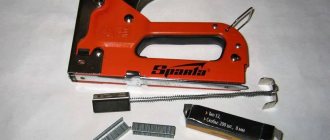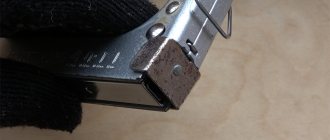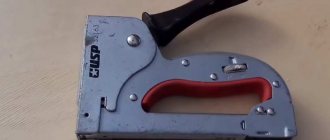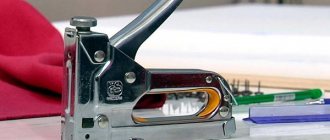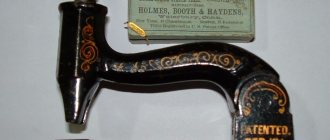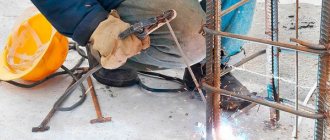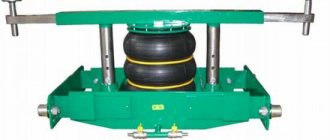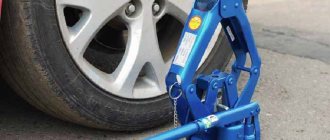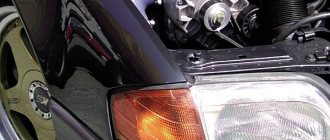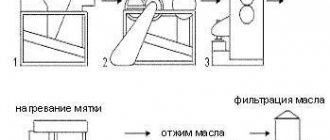How to insert staples into a stapler
Before answering this question, let's briefly look at the features of the tool and consumables. In particular, staplers come in 3 types:
- mechanical (manual);
- pneumatic;
- electric – mains and battery.
It should be noted that this is the main classification, but there are others. For example, this tool is divided into 2 groups – professional and household. In addition, depending on the purpose, there are stationery, construction and furniture. Each type is designed to perform specific tasks. For homework, a household tool is quite enough, because you will only use it from time to time. Accordingly, buying a professional stapler will only be an unjustified waste of money. There is nothing to say about stationery staplers - these are very simple devices, probably familiar to everyone.
It should be emphasized that the charging principle for all staplers is approximately the same. Of course, there are some differences here, of course, but they are by and large insignificant. Let's look at the simplest example of how to correctly insert staples into a small stapler (also called a stationery stapler). Today, probably every family has such a device, so many people know very well how to prepare the instrument for use.
First of all, you need to pull up the back or front of the top cover. A clip will open in front of you. Now you should push the spring back until it stops, and then insert the plate with staples. Then all that remains is to return the lid to the reverse position, making sure that you hear a click. That's all - the stapler is ready for use. All that remains is to check it on some unnecessary sheet of paper, shooting off one or two staples.
A furniture stapler is charged using approximately the same principle. Only here, first of all, you must put the safety device on. This precaution will come in handy if you load staples into a large stapler, regardless of its type. The fuse is a good protection against accidental shooting, and therefore we do not recommend neglecting basic safety rules. Do not forget that a professional tool is quite powerful, and the staple may well fit tightly into soft tissue.
However, let's return to the main question. So, with the tool on safety, we need to gain access to the staple holder. There may be different options here. In some models you just need to pull the box towards you, in others you need to press a special button or release the latch. The instruction manual included with the tool will tell you how to do this. However, if there is none, it’s okay. Even a person who has never held such a model in his hands before can figure out what’s what. Everything is really very simple here. Having gained access to the cage, we put the plate with staples there and return the box to its original position. In many models, a characteristic click will indicate the correct action.
When inserting staples into an electric or pneumatic stapler, it is recommended to disconnect the tool from the mains or compressor. For a cordless tool, you just need to put it on the fuse. However, to be on the safe side, you can disconnect the battery. Well, the sequence of actions here will be the same. That is, we first gain access to the box, then fill it with consumables, and then return the clip to its place. Of course, there are minor differences here, depending on the model. However, they can hardly be called critical.
Separately, I would like to note the filling of printer or copier with staples. Here you will need to act somewhat differently. The main difference is that in this office equipment the entire cartridge with consumables is replaced at once. Accordingly, first of all you will need to buy a new one. When purchasing, be sure to check whether this type fits your printer or copier. After all, there may be different options here. Next, find the finisher and remove the empty cartridge from it. You can find out where exactly this compartment is located from the operating instructions or ask the corresponding request in an Internet search engine. Typically, you must press the release latches to remove the cartridge from the finisher. Now all that remains is to install a new cartridge.
And in conclusion, I would like to say a few words about staples for the stapler. They are different - primarily in size. Staples are also distinguished by the material they are made of. Therefore, before purchasing, it is better to consult with the seller which consumables are suitable, for example, for furniture. After all, the wrong choice may well have a negative impact on the quality of work. Additionally, many staplers do not work with small staples. Therefore, for each model you need to select consumables taking into account the size of the latter.
The material from which the staples are made is also important. For example, aluminum ones are the cheapest, but they are not reliable. Therefore, such staples can be used only if there will be no physical impact on the fixation site or for fastening thin materials. Copper staples are quite expensive, as are stainless steel consumables. They are used only in a fairly limited manner - mass use is simply unprofitable. The most popular option is regular steel staples. This is probably the best ratio between price and quality. By the way, you can simply take one of the staples, or the paper box itself, to the store - in this case, it will be simply impossible to make a mistake with your choice.
Source: specinstrumenta.ru
How to charge other types?
Electric staplers operate by ejecting the staple after pressing the drive button. Such a device requires a network connection to a power source to operate. Among the assortment, you can choose the optimal model with a rechargeable battery or connection to a network adapter.
The dimensions and cost of electric staplers are significantly increased compared to conventional staplers. In addition, such devices have a bulky handle and an inconvenient cord location.
The pneumatic type is activated by supplying compressed air, which promotes the ejection of consumables from the store. The devices support long-term battery life, are spacious and have high performance. At the same time, pneumatic staplers have the disadvantage of noise emitted during operation. Such a device of impressive size is inconvenient to transport. Most suitable for construction professionals.
Learning how to use a staple gun is quite simple, but you need to read the instruction manual and make sure the tool is set up correctly in order to change fasteners. If you need to remove staples hammered into the surface, you will have to use an anti-stapler. To remove furniture brackets, you should carefully squeeze out their ends using a screwdriver or pliers when you do not have a special tool for removing them.
The construction stapler is refilled as follows.
- Before disassembling the spring, you need to lock the device using a button or lever. The type of blocker depends on the characteristic features of the model.
- The groove is pulled out. You need to make a physical effort or press a button.
- Pull out the inner rod by displacing the metal spring. Place the paperclips on the rod. The tip of the device should be facing towards the handle.
- The rod is inserted back, then the magazine is closed.
- The device is removed from the safety lock and test shots are fired to check its functionality.
After testing the device, you need to make sure that it functions without failures. To do this, adjust the spring tension and follow safety precautions. Please remember that the device is potentially dangerous. Working with it requires the following precautions:
- after use, you need to install the fuse back;
- It is prohibited to direct the device towards oneself or any living creature;
- It is not recommended to handle the device if you are feeling unwell;
- the workplace should be clean and the lighting should be bright enough;
- The stapler should not be used in damp rooms.
In order to correctly insert the brackets into the furniture unit and replace the consumables, you must open the lid or pull out the corresponding container before charging the device. After this, pull back the feed mechanism, then install the clip into the body. By filling the device with brackets, the mechanism is loosened and the clip is secured. Close the fixture or push in the tray.
Penetration of the material is realized by pressing the working area towards the area that needs to be fixed. Next, the lever is activated, causing the staple to pierce the surface.
How to insert staples into the receiver
The design of all mechanical hammers is almost the same. There is a handle-lever, due to which pressing occurs, and at the bottom of the stapler there is a metal plate that opens the receiver. This is where we have to load the staples.
Before you buy brackets at a hardware store, you need to find out what size will fit your device. As a rule, the size and type of suitable staples are indicated on its body.
For example, the body of our stapler indicates a width of 12 mm and a depth of 6-14 mm. This means that you will only be able to charge staples in this range.
Smaller or larger brackets will not fit into the receiver. The size of the staples in millimeters is also indicated on their packaging.
To insert projectiles into the stapler, you need to open the metal plate on the back surface.
To do this, you need to take it with your thumb and forefinger on both sides, then pull it towards you and slightly down. Thus, we press the metal tab on the back surface of the plate, and pull out a metal spring, similar to the one found in a regular office stapler.
If there are any staples left in your stapler, they will fall out once the spring is pulled out. If they are not there, then it’s time to install new ones for further work.
The staples are inserted into the receiver (the hole is in the “P” position). Next, insert the spring back, closing the metal tab. That's all, the tool is loaded and ready to go!
How to open and thread a large stationery stapler with staples: description, video
How to open and load a large office stapler with staples: description, video
So, you bought staples and want to load the stapler. How to open and thread a large stapler with staples? Description in the form of instructions:
- Bend back the plastic cover of the stapler, which is held on by a spring. Opening the roof pulls a spring. The freed up space is the staple groove. Many large staplers have latches that need to be pulled back.
- Take the staples - one section. Insert them into the groove, the ends should point down.
- Close the stapler cover.
- Click them once without paper. If a paper clip with bent ends falls out, it means the stapler is working.
Advice: If the staple that has fallen out is bent incorrectly or has not fallen out at all, then repeat the procedure or buy another stapler; there may be a malfunction.
You can watch the video to learn how to thread the stapler correctly. A visual demonstration will help you cope with this process quickly and without problems. In addition, the video explains how to repair a stapler.
What to do if a bracket gets stuck
It is worth noting another very important point that will help you in your work. It happens that the staples become bent and get stuck in the exit hole. They cannot be hammered into the surface and cannot be pulled out by hand.
In this case, we will need to pull out the feed magazine completely.
This option exists for almost all professional staplers.
First you will have to repeat the opening of the metal plate and pull out the spring.
Next, in the middle of the lower part of the stapler you need to find an iron part, slightly protruding from both sides. Grasp it tightly with your thumb and forefinger on both sides and pull down forcefully.
This will remove the entire feed magazine that was in the tool.
You will see a jammed staple that can now be easily pulled out by hand.
Putting the stapler back together is not difficult: the entire pulled out block returns to its place with a press. You should hear a click when you do this. Afterwards, do not forget to replace the spring.
Not just parentheses
Some staplers can work not only with staples, but also with studs of various shapes. The designations of what the stapler works with are indicated on its body or in the instructions.
I tuck the nails into the stapler in the same way as with staples, but you need to be careful after pulling out the spring. A row of nails must be loaded along one of the outer edges of the letter “P”, and not inside this very letter!
If you want it to produce two nails side by side when working with a stapler, load the second row along the second outer edge. Next, the spring is inserted and the stapler is closed.
Source: narodnyeokna.ru
The sequence of adjusting the stapler
Setting up a staple gun is needed in the following cases:
- after purchasing the tool before starting work;
- if the stapler stops completely driving in the fasteners;
- when starting to work with a material of a different density than the previous one.
If the stapler stops driving in the fasteners completely, this is due to gradual wear of the spring of the impact mechanism or its loosening. For some time, the adjustment will help, but after that you will need to purchase a new stapler.
You should take into account the dimensions of the fasteners for which the tacker is designed: if the size of the staples exceeds what is allowed according to the operating instructions, then adjustment has nothing to do with it, you just need to select the appropriate consumables.
Mechanical staple guns with a coil spring have a screw that regulates the degree of compression . It is shown in the photo below with a red arrow.
If you tighten the adjusting screw clockwise, the spring will compress more strongly and its potential energy will increase. The result will be a blow of greater force. The ejected staple will go deeper into the surface of the material. Turning the adjuster counterclockwise will loosen the spring. The blow will also become weaker. By rotating the screw, you can adjust the stapler to work with material of varying hardness (density).
For mechanical models of staple guns with a spring (leaf) spring of the impact mechanism, the regulator is located under the handle. By rotating it in different directions, the force of the shot is adjusted. It is necessary to reconfigure the impact mechanism every time you start working with a different material. After adjusting the spring compression, it is recommended to test the tool's performance on a workpiece that is no longer needed.
The adjustment process ends when the fastener with the entire length of the legs enters the material without piercing it with the “back”. It is recommended to practice by rotating the adjuster from minimum to maximum spring compression.
How to insert staples into a stapler
To understand the specifics of refilling a stapler, it is necessary to determine the principle of its operation and the type of driving force. The following types of staplers are offered on the market:
They are also divided into 3 groups depending on the moving mechanism:
- Mechanical.
- Electrical.
- Pneumatic.
Representatives of the first group work using arm strength and demonstrate weak power. They hold a small number of staples and are not capable of nailing thick or hard structures.
At the same time, mechanical models are characterized by compact size and lightness, so they are convenient to use in hard-to-reach places. Such devices are also in demand due to their low cost and availability.
In electric staplers, the staple flies out only after pressing the corresponding button. However, the device is brought into operating mode only after electrical power is supplied. Models with battery or network connection are available for sale.
Electric staplers are much more expensive than mechanical ones. They are also distinguished by their increased dimensions.
When working with network models, you may encounter discomfort due to the specific placement of the cord. Cordless staplers have a bulky handle and weigh quite a lot.
Representatives of the pneumatic group operate by supplying compressed air, which helps the staples or nails fly out of the magazine. The devices have increased performance and a spacious magazine, so they can be used for a long time without charging.
A negative aspect of pneumatic staplers is considered to be noise during operation. This is due to the presence of a compressor. Moving with such a device is quite problematic, so it is better to use it for professional purposes.
When doing home finishing work or gluing simple materials, it is better to choose mechanical and electric staplers.
How to refill a construction stapler
Novice builders do not fully understand how to use a construction stapler, so they often wonder about refilling it. The process itself does not require much effort, provided that the employee follows all the rules and recommendations. To thread a construction stapler, you need to follow this guide:
- Before disassembling the spring, you must lock the device using the appropriate lever or button. The type of blocker is determined by the features of the model.
- There is a groove on the reverse side. Sometimes you need to apply mechanical force or press a button.
- Next you will need to remove the inner rod by displacing the spring and place it on the staple rod. The tip of the device is directed towards the handle.
- At the next stage, the rod returns to its original place, and the magazine closes.
- Finally, all that remains is to remove the tool from the safety lock and perform test shots to check its functionality.
How to refill a mechanical stapler?
Furniture staplers are divided into three types:
- mechanical;
- electrical;
- pneumatic.
It is necessary to take into account the specifics of refilling the tool, which directly depends on its moving mechanism.
The design of such staplers is not much different from each other. They consist of a lever handle, through which mechanical pressure is applied, and at the bottom of the tool there is a metal plate that opens the receiver. This receptacle can accommodate staples.
The mechanical type is driven by the applied force of the hands, which indicates their weak power. The model contains a small number of staples. With their help it will not be possible to nail hard and thick structures. However, such assistants are light in weight and compact in size, so they will be needed for processing hard-to-reach places. The mechanical type of stapler is available due to its low price, is compact for carrying and easy to maneuver.
To insert staples into a mechanical stapler, you must follow these steps:
- To refill the stapler, you must first open the plate. To do this, you should take it on both sides with your thumb and forefinger, and then pull it towards you and down a little. Due to this, the metal tab located on the back of the plate will be pressed out.
- Then you need to pull out a metal spring, similar to the one found in an ordinary office stapler. If the staples are still loaded, they will fall out of the stapler when the spring is pulled out.
- The staples must be inserted into the receiver, which looks like a U-shaped hole.
- Then the spring is returned to its place and the metal tab is closed.
After completing these steps step by step, the tool will become suitable for further use.
How many shells will fit into a stapler?
There is a wide range of staplers with different working holder sizes. Staples can be purchased in small rows that are separated into sections by hand. 1 stapler can freely accommodate 1-1.5 rows, which contain more than 20 staples.
When choosing brackets, builders and furniture makers are guided by their depth. This figure varies from 4 to 14 mm depending on the type of work being performed.
So, to upholster furniture items with fabric surfaces, you need to purchase a bracket with a depth of 8 mm. Fixing thicker structures requires choosing staples with greater depth.
The following types of staples are available in the market:
- 53 - is in greatest demand and has a width of 11.4 mm and a thickness of 0.7 mm. The fastening depth is 4-14 mm.
- 140 - characterized by a width of 10.6 mm and a thickness of 1.2 mm. The depth indicator is equal to the previous variety.
- 36 - the marking indicates brackets with a semicircular shape; they are in demand when laying cables.
- 300 - are a special type of stapler nails.
At the selection stage, you should also pay attention to the material of manufacture of fasteners.
Simple steel products are in demand for processing wooden structures. But if you are working with particle board or plywood, it is better to choose models made of hardened steel. They have an extended service life and cannot be bent.
What kind of staples are produced for construction staplers?
Staples are consumables that are needed to connect two elements (fabric to wood). Consumables are divided into various types according to the following criteria:
- Material of manufacture
- Degree of hardness and strength
- Availability of additional protective coating
- Dimensions
- Form
Let's consider what types of staples there are, depending on the above criteria.
Material for making staples for a stapler
Manufacturers produce staples from various materials, which allows them to expand their scope of application. They come in the following types:
- Aluminum - used for working with non-solid types of materials
- Copper - these staples are also called decorative, as they are intended for covering furniture with various types of fabrics
- Steel ones are the most popular and inexpensive. They can be used for driving not only into soft, but also hard materials. The main disadvantage is that they rust over time.
- Stainless - made of stainless steel, and used when it is necessary to prevent the occurrence of corrosion processes
Additional zinc coating of the brackets eliminates the occurrence of corrosion processes. When choosing fasteners of the appropriate material, it is necessary to take into account what you plan to connect.
The hardness of staples and what it affects
The greater the hardness of the consumable, the higher the efficiency of its penetration into the surface of the driven material. To understand why staples of different hardnesses are produced, you need to imagine a picture when it is necessary to drive a staple into a board made of hard wood. A soft aluminum or copper staple will not penetrate the surface of such wood. The result is a damaged bracket with bent legs. To prevent this from happening, manufacturers produce consumables with the following hardness names:
- Simple
- Very hard
- Red-hot
A description of the degree of hardness of the staples is presented in ascending order. The ends of the devices may have additional sharpening, which allows for effective insertion of the part into the surface of solid materials with the least resistance.
What to do if a bracket gets stuck
When using a construction stapler, a problem such as breakage of the staple inside the receiver often arises. Fasteners often become bent or stuck in the outlet, causing many problems. To restore functionality, you will need to completely remove the magazine with staples. Professional models have a removable receiver, so repairs will not take much time.
First of all, you should open the metal plate and take out the spring. Next, in the middle of the stapler you need to find an iron part and tightly clasp it with your fingers. This will allow you to remove the entire magazine and remove the jammed bracket.
Reassembling the tool does not require much effort: the removed magazine is put back in its original place, after which a characteristic click should sound. Next, all that remains is to return the spring to the groove.
If you are using a power tool, be sure to adjust the special screw when using the rough material to check. During this stage you need to rotate it from minimum to maximum. If the bracket is well secured from the first shot, proceed to work on the “finishing” part. In other cases, the procedure will need to be repeated.
A furniture stapler is a universal construction device that is suitable not only for upholstery activities, but also for more complex work. If you use this tool correctly, it will serve you for a long time and with high quality.
Types of staplers
First you need to decide what type of stapler you need. These devices are classified according to the type of driving force.
Mechanical
They are operated using hand strength, have low productivity, and a small number of staples that can be “filled” into it. When working with hard materials, this tool is quite complicated and requires considerable effort.
However, mechanical tackers have relatively small dimensions and light weight, which makes it possible to work in awkward positions. In addition, many are attracted by their low price, although there are also models with a fairly high price tag.
Electrical
In such tools, the staple flies out when the trigger is pressed, but the mechanism is driven by electricity. There are models that run on batteries, and others on mains power.
Of course, the productivity of such staplers is much higher than that of mechanical ones, but their prices are much higher, especially for battery-powered types. The dimensions are also larger.
Important! For models that operate from the mains, the cord may interfere with operation, and for battery-powered types, the bulky handle and weight are inconvenient. But physical effort is reduced to a minimum.
Pneumatic
Here the driving force is compressed air, under the influence of which nails or staples fly out of the magazine. Such devices have high productivity and a fairly large magazine - you can refill a furniture stapler with a large amount of consumables at once.
However, the disadvantage of pneumatic models is that they operate from a compressor, which makes a very loud noise. It is very difficult to move with such a unit, so this type of tackler is more appropriate for professional use in a specific place.
Important! If you need a construction stapler only for one-time work - only during the construction or finishing of a house, then it is better to choose a mechanical or electrical model.
How to insert paper clips into a stapler?
Today, no office is complete without a stapler. Note that this device can also be used at home. After all, a stapler is an ideal way to staple paper sheets. Note that the stapler can staple paper, both permanently and temporarily. Different types of matrices allow you to solve both problems for specific needs.
Naturally, from time to time staplers need a new batch of staples. And here it is important to choose a model that has the most comfortable mechanism for performing this action. The market offers a wide variety of options. To choose the right one, try inserting a block with paper clips directly in the store (exclusively yourself).
How to choose a quality pneumatic stapler?
First you need to decide on the range of planned actions. The conditions in which the tool will be used, the amount of consumables and the condition of the working surface determine the parameters that you need to rely on when choosing. For furniture production, universal models are suitable, which maintain a balance of efficiency in performing work and ergonomic qualities.
Super universal stapler Stanley Fatmax TR75.
If you plan to use the unit at home, it is better to choose an entry-level pneumatic model. Such equipment allows targeted activity with small hardware. If you plan to work with textiles, such a tool will be quite sufficient.
For plywood you will need a pneumatic nailer.
Special mechanism for installing new blocks with staples
This approach to organizing the device design is the most attractive:
- no effort is required to reach the staple compartment;
- Injuries when installing new staple blocks are eliminated.
The idea is to press the button on the back of the stapler. It has specially selected colors and has a rubberized surface. At the same time, it is located in such a way that it is impossible to press it accidentally.
A tray pops out from the front end of the stationery, where you will need to insert a new block of paper clips.
As far as can be noted, the procedure for inserting new paper clips takes a matter of seconds. However, most stapler models have a less advanced mechanism.
To get to the tray you have to open the top of the stapler. If closing (already with paper clips inside) is not done carefully, you can accidentally puncture your finger.
general information
If you have long been interested in the question of which stapler is better to choose, then it will not hurt you to first find out how this tool for fastening papers works.
Principle of operation
Its design includes a metal groove for inserting staples. To move them forward, a special spring or plate is provided. The latter option is considered more practical, since the spring begins to stretch over time and at one point may come off the hooks on which it is attached.
Thanks to the plate, the staple-moving tongue will operate smoothly. Its main task is to ensure that the clip of staples is constantly located at the edge. The push rod is usually made of metal or plastic. And it’s best if this is the first option, which is characterized by increased reliability.
Loading the stapler
Before work, the staples must be placed in the internal mechanism, after which, when you sharply press the device, staples will shoot out of it and fasten the sheets. When all the clips are used up, you just need to insert a new one to continue working.
Typically, full-load stapler models require one new plate of clamped staples to be inserted. However, there are models in which half the clip is enough to replace the spent staples. It's easy to understand how pocket and office staplers work and how many staples they require. You can easily figure out how to change the plates, for which you don’t even need to look for a diagram of the stationery stapler. You just need to lift the top cover and insert a new clip into the groove.
Office supply stores also offer front-loading staplers. These models have a special button on the body, when pressed, the spring of the mechanism is released and the chute moves forward.
We invite you to familiarize yourself with Floor installation in a country bath
Owners of professional devices may experience certain difficulties in replacing staples. Among them there are models that allow you to load 7 types of staples. But they have one feature - they allow users to choose the bonding depth at their discretion.
Replacing the matrix for compact storage of stapled sheets of paper
The matrix is often a stapler where the ends of the staples rest and bend under force. Moreover, they can bend in various ways. The most common is when the ends of the paper clips form semicircular parts.
In view of this, when storing stitched sheets in folders, there is an irrational use of space. Things are different when the ends of the paper clips are bent flat.
Often the matrix is rotating. It is enough to turn it to the opposite side to enter the stapler into temporary stapling mode. In this modification, a bent paperclip can be removed using two fingers and nothing more (unbending the paperclip is not required to separate the stitched sheets again).
In the video you can see all aspects of using a stapler in practice:
Source: postroyka.org
How to insert staples into a furniture stapler?
Today, the variety of specialized staplers for various types of work is numerous. You can buy them in stores for a variety of purposes; in a stationery store you can buy products intended for papers. But in a hardware store you can see what you need for repairs.
The favorite type remains the furniture option. After all, it is used to carry out restoration and insert other furniture elements during construction and repair work. It can be used for cosmetic and major repairs of an apartment.
To use a furniture stapler, let’s explain some points. Namely, what types of staples are there and how they are used. An important issue will be the use and change of brackets in the operation of the device, since the issue of changing brackets worries users.
How to use it correctly
Despite the apparent simplicity of design, working with a furniture stapler requires compliance with a number of rules. Today, several of the most popular and very easy-to-use modifications of the tool are produced (pneumatic and manual types, electric models), but the technology for their use is in most cases common.
The main stages of working with a furniture stapler:
- Move the spring and fill the tool with staples through a special groove.
- Return the spring to its original place and check that the tool is ready for use.
- Press the tool firmly onto the location chosen for fixing the bracket.
- Press the special lever or trigger button.
The success of the “shot” fired is determined by the characteristic sound and the presence of a staple embedded in the upholstery material.
Characteristics of furniture stapler staples
There are a variety of staplers on sale, but most work on so-called standard staples. And only type 53 belongs to them. There are 104 and many others. But the main difference is in characteristics and thickness. After all, the higher the number in the indicator, the thicker the staple increases. Application differs on different materials.
But the 53rd model has average width and thickness of 11.4 and 0.7 mm, respectively. These numbers are not so important, but to find out what type of brackets your model runs on. It is worth carefully studying the operating and replacement instructions. Everything will be spelled out in detail there.
When purchasing, you should ask your consultant about the types of staples. After all, there are models that are difficult to find on sale or the cost will be much more expensive.
Depth will be a factor when choosing staples. The depth indicator affects how deep the bracket itself will go. This indicator has different values, as it will depend on the material of manufacture and the purpose of use.
Simple ones are 4–8 mm. They are made mainly of plastic and are designed to attach and insert small materials. It is used infrequently, and the cost is low - 100 rubles.
- From 4 to 10 mm is the best option, but still not suitable. True, they are made of metal and correspond to 53 types of staples. But there is no adjustment screw.
- Staples 4–14 mm are a suitable option both in terms of cost and frequency of choice. Yes, and there is also a blow control screw. With its help, you can increase the force of the required blow, otherwise the staple may not fit well into the material.
There are types of hardened and simple staples. Tempered ones are intended more for materials such as particle board, since they can be held in place for a longer time using a furniture stapler gun.
Simple staples do not have such characteristics. They are simpler and not very reliable. True, this does not stop people from purchasing them.
Design and principle of operation of a construction stapler
The furniture stapler is widely used by builders and furniture makers, as well as representatives of other fields of activity. Based on the type of energy used to fire a shot during operation, the following types of takers are distinguished:
The first two types are intended for domestic use, while the last type of tool is considered professional and is used mainly when performing large-scale work. The operating principle of mechanical and electric staple guns is based on pushing out fasteners by the force of a cocked (compressed) spring. After pressing the trigger, it unclenches, which causes the striker to move. He strikes the staple (nail or pin), driving it into the surface of the material.
Mechanical stapler design
Manual (mechanical) staplers differ from their analogues in their simpler design. They consist of the following components and parts:
- cocking handle;
- a safety bracket that protects against accidental shots when transporting the tool;
- impact springs;
- shock absorber;
- drummer;
- striker;
- impact force regulator, providing the ability to work with material of varying degrees of hardness (different densities);
- housings;
- charging spring;
- store for fasteners;
- rammer (with spring and lock);
- tip that allows you to accurately drive fasteners.
The diagram of the staple gun device is shown in the photograph below.
The impact mechanism is the main unit of the stapler, cocked by the force of the worker’s muscles. It can be equipped with two types of springs:
- twisted;
- spring (plate).
Manufacturers indicate in the operating instructions for products the type of spring installed.
The twisted spring mechanism shown in the photo above is equipped with cheap models. They can be easily distinguished by the adjusting screw located on the tool body on the opposite side of the staple outlet hole. But it is also possible that the wing will be missing, then you will need to refer to the instructions to determine the type of spring installed.
Leaf springs are more powerful, but more expensive than their coiled counterparts. At the same time, the impact of a tool equipped with them during operation is less. They also have a long service life and are easier to cock. The leaf spring mechanism is installed on models intended for professional use.
To make it easier to work with the tool, the handle is covered with rubber pads, and the magazine is made with a transparent insert (which makes it easy to control the presence of staples or nails).
Design features of electric and pneumatic staplers
The device of a network-type electric stapler is shown in the photo below.
The numbers in the photograph correspond to the following structural elements:
- trigger;
- fuse;
- handle with special coating;
- power cord;
- on/off switch;
- shock force regulator;
- pusher mechanism;
- shop.
Inside the tool there are electric drive and impact mechanisms. In this case, the electric motor is designed to charge the spring.
Battery models do not have a power cord: batteries are installed instead.
The design of a pneumatic furniture stapler is more complex than its mechanical counterparts. Pneumatic tools consist of the following structural elements:
- housings;
- a cylinder with a piston located inside it;
- starting systems (trigger mechanism);
- magazine for fasteners with a pusher;
- impact mechanism;
- an inlet fitting designed to connect a high-pressure hose to the tool;
- regulator of penetration depth of fasteners (impact force);
- air distribution unit.
Pneumatic type scrapers are powered by the energy of compressed air supplied by a compressor or from a cylinder. After pressing the trigger, the gas passes through the air distribution unit. Next, the compressed air enters the cylinder, causing the piston to move. The latter transfers energy to the striker striking the fastener. After impact, the staple or nail is driven into the surface of the material.
